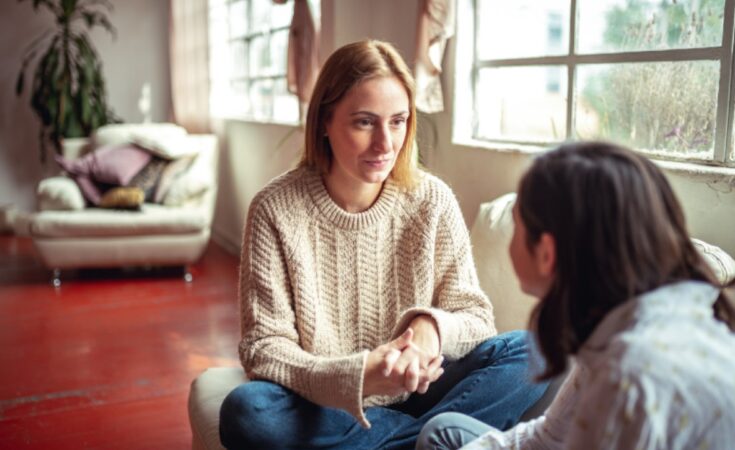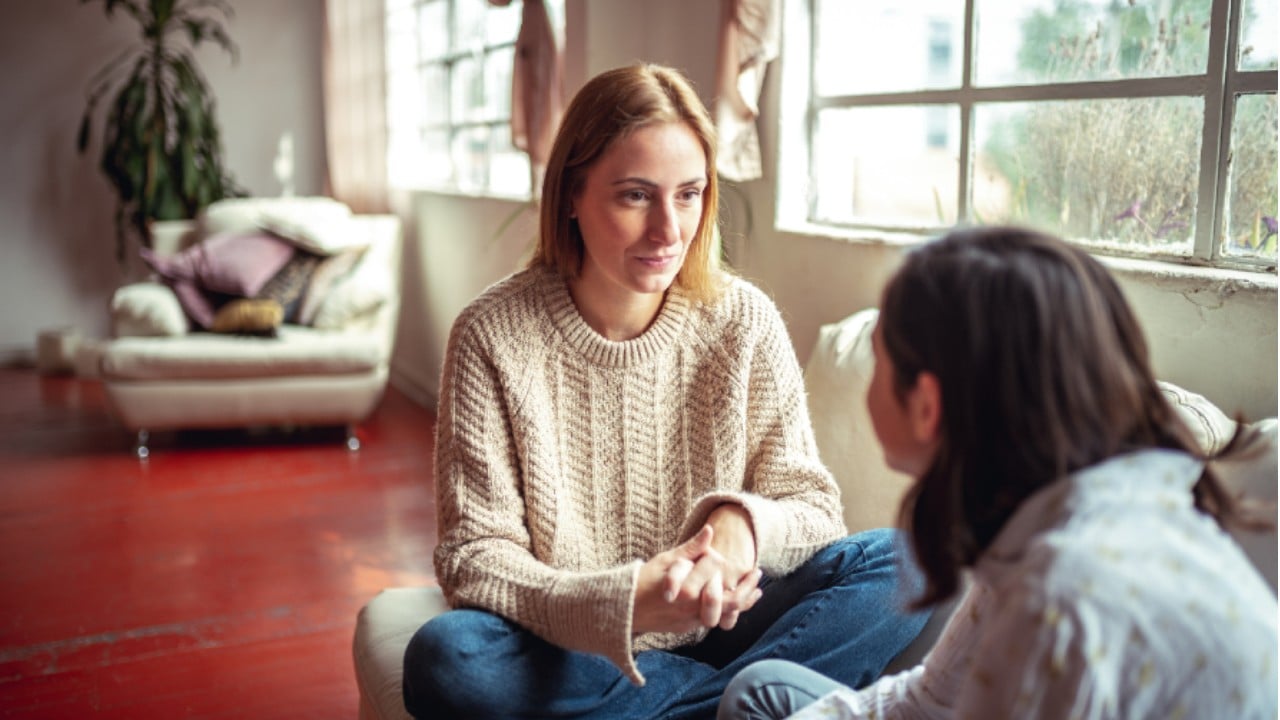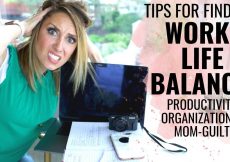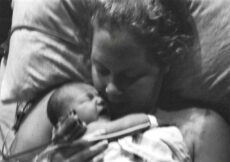With the recent American Supreme Court debate about whether or not to criminalize abortion and overturn Roe v. Wade, it’s likely kids will overhear the word “abortion” at some point and ask what it means. Whether it’s on the news, TV, radio or overhearing discussions by adults in their sphere, children are often fascinated by anything they sense provokes strong emotions. And while the thought of a child asking about abortion may make some cringe, scientific evidence has proven factual and honest sexual education is critical to healthy physical, mental and emotional development in children. Answering kids’ sexuality and reproduction questions with age-appropriate, non-judgemental, accurate answers is an important way to build safety, trust and connection with them.
Discuss the basics of body parts, reproduction and consent
The Ontario government states children as young as two years old are ready to discuss simple topics like correct names for body parts. Frédérique Chabot, Director of Health Promotion at Ottawa-based Action Canada for Sexual Health and Rights, cautions that discussing abortion can’t be a standalone conversation; it requires prep work in prior discussions that build a foundation of a child’s understanding and autonomy of their own bodies, personal choice-based consent, and reproduction.
“Consent in particular helps kids apply those understandings to abortion. We get to decide what feels comfortable for our own bodies and what we say yes or no to,” explained Chabot. “For kids, we teach and model for them being able to say no if they don’t want hugs or kisses or other unwanted touch. When they get older, kids will then be able to understand that a person has to also consent to a pregnancy in their body.”
Early discussions about consent do not have to involve sex or sexuality; experts have stated toddlers are capable of learning to say no to interactions with their body (like tickling) and parents should encourage and respect that. You can also tell a child that you are going to change their diaper now, or you want to give them a bath, so a child feels they are in control of their own body by being kept well-informed about what is happening to it.
“We want to teach kids the information they need to make smart decisions they feel good about and keep them safe,” echoes Saleema Noon, a sexual health educator from Vancouver who works with kids. “We teach the ‘3-Ps’: protection, prevention, and preparation. We teach proper body part names, what body parts do, how to take care of them. We want them to know their body is theirs and how to take responsibility for that.”
So how do these conversations lend themselves to discussions about abortion? When a child has an understanding of body parts and functions, they’re better equipped to know how pregnancy occurs. Chabot and Noon also recommend discussing pregnancy in child-appropriate scientific terms: ‘a sperm and egg come together in a uterus to make a pregnancy’ is a simple answer to start with. Chabon suggests using the term “baby” for full-term pregnancies after the fetus has left the uterus. Of course, most kids will have follow-up questions, and that’s completely normal.
Toronto child psychologist Carly Shecter says there is no right or wrong age to have these discussions. “It’s not a calendar age thing; a child’s developmental age is most important. Parents must consider what place a child is at in their understanding. There’s no one-size-fits-all script or response based on numeric age groups.” Action Canada has some great tips for parents on how to start and continue ongoing education rather than having “the talk” about “the birds and the bees” that was common in older generations. The organization suggests things like parents having a good knowledge base themselves with continuous self-education in preparation for kids’ questions, and avoiding cutesy names of body parts and their functions, and not sharing myths about sexuality (no, hands won’t fall off from masturbation.)
Shecter also supports discussions with child-appropriate language, using correct body part names and doing some role-playing when it comes to teaching and practising consent. She stressed the importance of creating a trusting relationship by being honest in answering questions kids have and not shaming them for bringing up those questions. It’s OK if a parent tells a child they need a bit of time to research and formulate the answer they’re most comfortable with, as long as they fulfill their commitment to return to the conversation.
Answering those tough questions about abortion
When one of the questions inevitably ends up being, “What is abortion?” Chabot, Noon and Shecter all agree that a simple response first is best, along the lines of, “Abortion is stopping a pregnancy from continuing.” All three also strongly recommend providing accurate and unbiased information, with additional discussions woven in about the values of their own and other families. You might need time to deal with your own emotions first before you can have a clear conversation.
Noon also suggested turning the question around and asking the child what they know about what they’ve asked so parents have a benchmark of where to begin the conversation or what they need to correct. Here are some suggested responses:
What is abortion?
The simple answer is ‘when a person is pregnant and stops the pregnancy from continuing.’ A more detailed response for older or more developmentally mature kids can include ‘when a healthcare provider gives a person medicine or does a medical procedure to stop a pregnancy.’
Why do people get abortions?
This can be tricky, as younger children love asking why, yet aren’t always equipped to understand the full socioeconomic or emotional reasons behind seeking an abortion. Shecter stresses that parents know their children best and to answer questions in ways they feel their child can fully understand. Noon suggests asking, ‘Why do you think somebody would not want to continue being pregnant?’ and expand the conversation based on what the child shares.
For older kids, it’s good to state the reasons at a high level, such as, ‘People may not feel emotionally or financially ready to be pregnant or become a parent, they may have gotten pregnant by accident or against their wishes, they may have a medical concern that makes pregnancy unsafe or the fetus may have severe medical problems.’
Why are so many people talking about abortion right now?
Young kids might not understand the legal and human rights issues around abortion, so parents can simply say, ‘Many people have big feelings about abortion and sometimes stories in the news bring out those big feelings so people talk about it.’ For older kids, it’s fine to tell them what is happening in the USA in unbiased language and tone.
For most adults, it’s hard to talk about abortion without inserting personal beliefs and emotions. Noon says go ahead and share with your child what your family values are, as well as straightforward, factual information about abortion. It can also be a good chance to discuss safe sex, if a child is attentive enough for an expanded dialogue.
Sometimes younger kids simply want a short, simple answer and will return later with follow-up questions after they’ve mulled over what they’ve been told. The key here is to create a safe space where kids feel validated, their concerns are addressed, and their questions are answered in a non-judgemental way; that’s also an open door for other related sexuality conversations. Media and interactions with friends and family may provide opportunities to discuss sexuality as well, like somebody announcing a wanted pregnancy, or a TV show where there is hugging or kissing without demonstrated consent.
Chabot hopes that personal opinions on abortion never prevent parents from neutrally discussing the facts with children when they ask. “Sexuality education is about keeping kids safe. One out of three people who can get pregnant in Canada has had an abortion and it’s something that’s been practiced throughout history. Withholding proper information leaves kids scared, misinformed, and misses the opportunity to discuss family values and how to uphold them (like discussions about abstinence or effective birth control) instead of using guilt and fear.” Noon also made the excellent point that creating a welcoming environment to discuss sexuality with kids allows parents to correct kids’ misconceptions they may have gotten from others.
Keep the conversation going
Sex-positive parenting is an ongoing part of communication with kids, whether the children come with questions or comments, or the parents initiate the discussion. It’s important to keep things conversational and non-judgemental, even if parents didn’t receive that kind of sex education growing up. Kids need safety and understanding from parents or they’ll simply go to other sources to get information they want. It’s OK to admit to feeling uncomfortable and to tell kids these topics weren’t openly and honestly discussed in earlier generations, but make sure they also know they can ask anything and won’t get in trouble or told not to ask such things.
Sexuality is a part of life and parents can’t prevent that by pretending it doesn’t exist. In countries like the Netherlands, where sexual education begins at age four and is broad, inclusive and discusses every aspect of sexuality, studies have shown that kids there are the ones who reap the most benefit like lower teen pregnancy rates and lower rates of STI. Regardless of personal opinions on abortion, parents all want safety, wellness and a mutually trusting relationship with their children. The tools for building that relationship are simple: being open and honest with accurate information.
Parent resource centre
Looking for additional support? Check out:
Books:
Talk Sex Today: What Kids Need to Know and How Adults Can Teach Them
Sex is a Funny Word: A Book About Bodies, Feelings, And You
What’s An Abortion Anyway? (Currently only available in the USA, but a newsletter signup is available.)
Videos:
What is an Abortion? – An American-based video for older children that includes discussion of the legal aspects of abortion in the USA
Nadine Thornhill, Sexuality Educator – a YouTube Channel with videos on sexuality topics, particularly the #SaveSexEd series, which teaches the Ontario sex ed curriculum across all ages.
Websites:
Action Canada for Sexual Health & Rights – a Resources page full of reports, factsheets, helpful tools and more.
Saleema Noon, Sexuality Educators – Workshops and Resources available to assist parents with sexuality education, including a Sexual Health Education Checklist by age group
Stay in touch
Subscribe to Today’s Parent’s daily newsletter for our best parenting news, tips, essays and recipes.
= 0;if(!is_postback){return;}var form_content = jQuery(this).contents().find(‘#gform_wrapper_13’);var is_confirmation = jQuery(this).contents().find(‘#gform_confirmation_wrapper_13’).length > 0;var is_redirect = contents.indexOf(‘gformRedirect(){‘) >= 0;var is_form = form_content.length > 0 && ! is_redirect && ! is_confirmation;var mt = parseInt(jQuery(‘html’).css(‘margin-top’), 10) + parseInt(jQuery(‘body’).css(‘margin-top’), 10) + 100;if(is_form){jQuery(‘#gform_wrapper_13’).html(form_content.html());if(form_content.hasClass(‘gform_validation_error’)){jQuery(‘#gform_wrapper_13’).addClass(‘gform_validation_error’);} else {jQuery(‘#gform_wrapper_13’).removeClass(‘gform_validation_error’);}setTimeout( function() { /* delay the scroll by 50 milliseconds to fix a bug in chrome */ jQuery(document).scrollTop(jQuery(‘#gform_wrapper_13’).offset().top – mt); }, 50 );if(window[‘gformInitDatepicker’]) {gformInitDatepicker();}if(window[‘gformInitPriceFields’]) {gformInitPriceFields();}var current_page = jQuery(‘#gform_source_page_number_13’).val();gformInitSpinner( 13, ‘https://www.todaysparent.com/wp-content/plugins/gravityforms/images/spinner.gif’ );jQuery(document).trigger(‘gform_page_loaded’, [13, current_page]);window[‘gf_submitting_13’] = false;}else if(!is_redirect){var confirmation_content = jQuery(this).contents().find(‘.GF_AJAX_POSTBACK’).html();if(!confirmation_content){confirmation_content = contents;}setTimeout(function(){jQuery(‘#gform_wrapper_13’).replaceWith(confirmation_content);jQuery(document).scrollTop(jQuery(‘#gf_13’).offset().top – mt);jQuery(document).trigger(‘gform_confirmation_loaded’, [13]);window[‘gf_submitting_13’] = false;}, 50);}else{jQuery(‘#gform_13’).append(contents);if(window[‘gformRedirect’]) {gformRedirect();}}jQuery(document).trigger(‘gform_post_render’, [13, current_page]);} );} );]]>
Read The Full Article Here



































